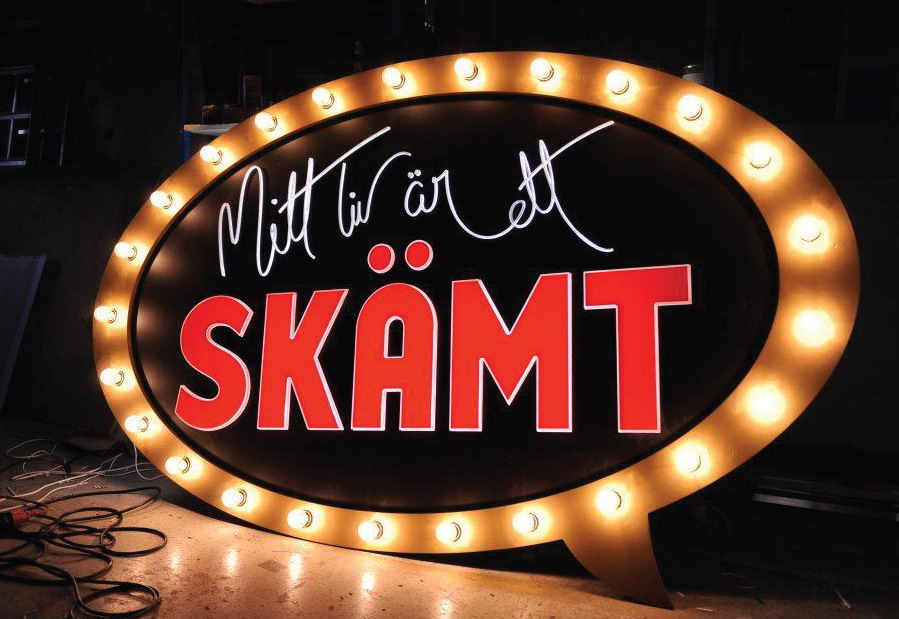Henry Barker, a native Briton, wanted to study art as a student, but was steered into agricultural school by his father. After job-hopping around the U.K., he became a commercial driver, he drove rigs and handled equipment for touring musicians. In 1985, he worked as a roadie for Bruce Springsteen; when The Boss’s tour hit Sweden, he fell in love with the country – “The women were gorgeous,” he quipped – and moved there four years later.
On a return visit to the UK, he met a signmaker and was encouraged to start his own business. He founded his business in 1992; his first job was decorating a van with cut vinyl and using 1Shot and a brush to make a drop shadow over the material. However, as his signmaking aspirations grew, he understood that he needed better software and equipment, and he resumed roadie life periodically to buy the necessary tools.
In 1996, he began renting his industrial shop. While he admired the more colorful signs of his native land, when he looked around at a seemingly endless procession of backlit, plastic signfaces, he saw opportunity.
“People told me, ‘You’re in Sweden now; you have to follow our trends,’ but I never have,” Henry said.
Although he does periodically bid on jobs, Henry said the majority of his work stems from repeat busi-
ness or word-of-mouth referrals. He also noted that, although most cities uphold thoroughly outlined sign standards, administrators are usually reasonable and flexible in approving nonconforming signs and graphics.
He plied his trade with hand tools until 2004, when he was hired to build a stage floor for a production of Mamma Mia!, the famous musical that features tunes from ABBA, the former Swedish supergroup. Such a large piece required him to purchase a router; he bought an AXYZ machine. This purchase opened a whole new realm of fabrication possibilities, and 3-D building signs became much more prominent in his repertoire.
Last year, he upgraded to a custom-made, 7 x 10-ft. Kimla router, made by a Polish manufacturer and built to Henry’s specifications. He added a servo-driven, rotational 28-in.-tall Z-axis, which allowed him to machine blocks of wood or urethane instead of needing to slice them. To enhance his work, he also bought an industrial 3-D scanner – made by the Israeli firm Optimet – which allows him to capture an image and plot a design at up to 3,000 points per second.
“Now, we can rout prototypes, mold forms and produce large pieces quickly and precisely,” Henry said. “People want work done more quickly and better than ever, and this helps me create value-added projects for my customers.”
Advertisement
He hasn’t abandoned his connection to show business; he recently fabricated a sign for a Swedish reality show, Mitt liv är ett skämt (“My Life is a Joke”), where aging actors and celebrities attempt stand-up comedy. He routed the sign from MDF, and coated it with vinyl and acrylic paint.
“Looking ahead, I’m fascinated by future possibilities for 3-D shapes,” Henry said. “Cubify and other soft-
ware companies have made them much more accessible for the average person. Advances with software, routers and scanners will help everyone in our industry handle more complex and creative products going forward.”



 Photo Gallery2 weeks ago
Photo Gallery2 weeks ago
 Paula Fargo1 week ago
Paula Fargo1 week ago
 Real Deal1 week ago
Real Deal1 week ago
 Photo Gallery1 week ago
Photo Gallery1 week ago
 Projects1 week ago
Projects1 week ago
 Women in Signs2 weeks ago
Women in Signs2 weeks ago
 Signs of the Times2 weeks ago
Signs of the Times2 weeks ago
 Business Management6 days ago
Business Management6 days ago







